
Restoration
The Restoration
Jameson House (formerly Bettyglen House) is an Arts & Crafts property designed by Batchelor and Hicks Architects for the Jameson family, of Irish whiskey fame, and is a sister property to Sutton Castle Hotel (now apartments) and Portmarnock Golf Links Hotel. All three properties were built for the Jameson family and are located in north Dublin coastal locations – with Jameson House being closest to the city centre, situated on over one acre of gardens and located in Raheny, adjacent to the seafront, St Annes Park and less than 8km from Dublin’s Financial Services Centre. The principal rooms face east towards Dublin Bay.

Jameson Whiskey
John Jameson was originally a lawyer from Alloa in Scotland who prior to locating to Dublin married Margaret Haig, eldest daughter of the famous Scottish whiskey maker John Haig. Jameson commenced distilling in Bow Street, Dublin in 1780 with successive generations of the family running the business until the 1900’s. The business was hugely successful from an early stage and the Jamesons’ became the most important distilling family in Ireland. By the turn of the 19th century Jameson was producing 1m gallons annually, helping cement Dublin’s status as the centre of world whiskey production.
Growth continued and by 1805 Jameson had become the world’s number one whiskey.
[The industry in Ireland declined in the 1900’s due to: (i) the Irish War of Independence and the subsequent trade wars with the UK; (ii) the era of prohibition in the US (while Scottish brands could slip across the Canada-US border, Jameson was excluded from its biggest market for many years); and (iii) successful adoption by the Scotch industry of column stills by Scottish blenders in the mid 1800’s which enabled lower cost production than Irish single pot still whiskey. In 1966 Jameson merged with Cork Distillers and John Powers to form Irish Distillers Group with production moving to the New Midleton distillery in Cork in 1976. The Jameson brand was acquired by the French drinks conglomerate Pernod Ricard in 1988 when it bought Irish Distillers].
Today Jameson is Ireland’s most successful whiskey export and the world’s third largest single-distillery whiskey. The original Bow Street distillery is now a museum, greeting over 600,000 guests annually (a visit being highly recommended). The site now also includes a maturation warehouse where Jameson 18 Bow Street is finished before being bottled as Cask Strength.
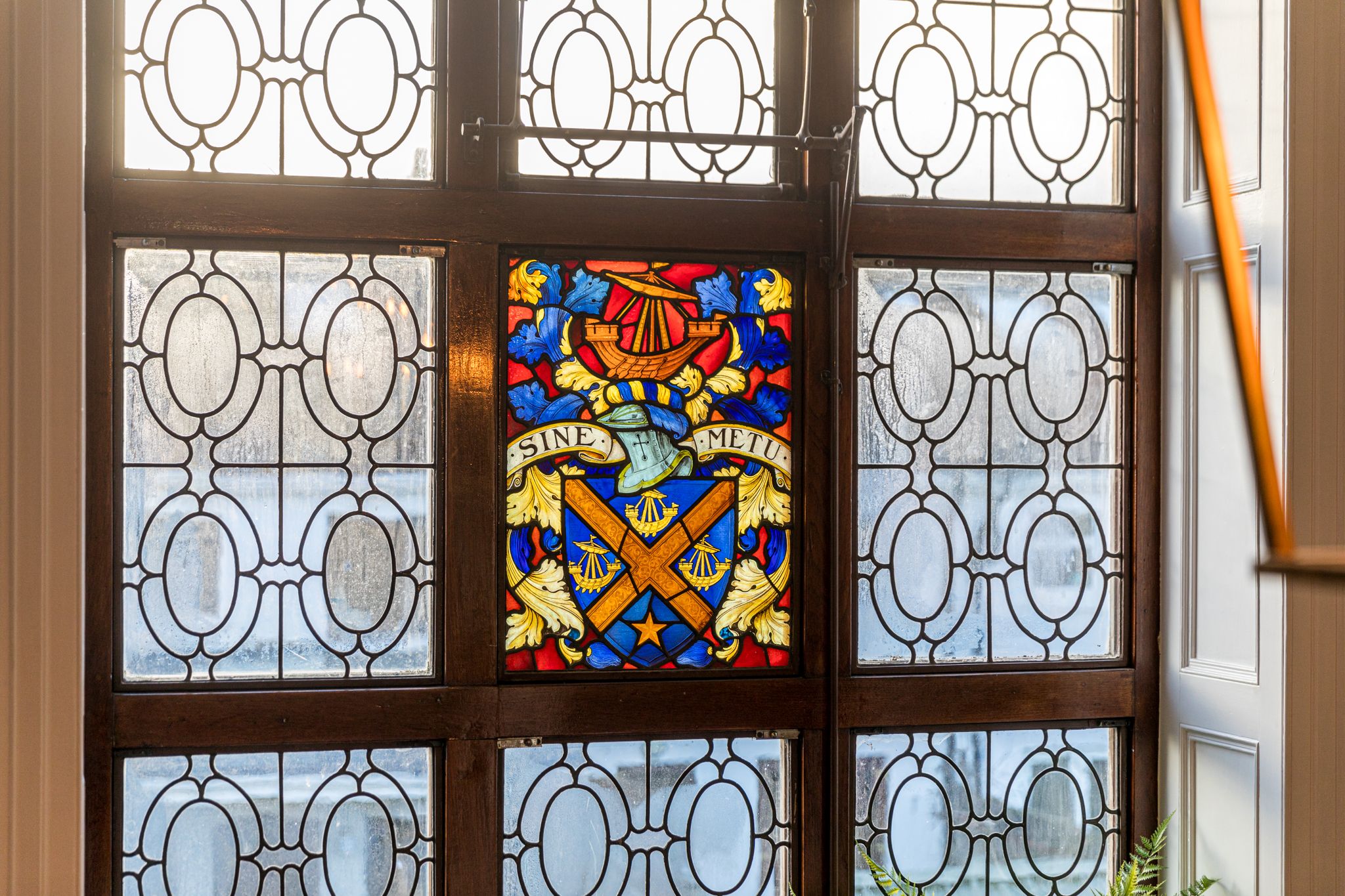
The family crest is also the centrepiece feature in the leaded stained glass window set alongside the main openwell staircase.
An Attention to Detail
The property has been furnished through to an exquisite standard. The development is spread over 1 acre and includes wild green gardens and private parking for residents. Overall, the 12,000 sq. ft property contains 50 rooms, 27 fireplaces, 97 windows. The refurbishment over the past seven years has adopted a gold standard approach to sustainable and sympathetic refurbishment to bring this ‘forgotten’ building back to life.
Jameson Family Crest
The Jameson family crest is prominently displayed in a granite and limestone carved heraldic plaque over the main entrance door, containing the Latin words ‘Sine Metu’ (‘Without Fear’) and displaying the same distinctive family crest still prominent on each and every label of Jameson Whiskey sold worldwide. The crest is also displayed as a centrepiece on a stained glass panel on the main internal staircase.

Granite carved heraldic family crest with George Jameson’s initials and the date of the house over the main entrance door.
Background and ethos of the refurbishment of Jameson House
Jameson House (formerly Bettyglen House) was bult in 1910 for George Jameson who lived there until his death, aged 82, in 1936. In recent decades, save for caretakers, the house has been uninhabited, and was acquired by its new owner in 2013 as a rare 100 year old time capsule. It contained all original Crittall metal windows, original fireplaces in almost every room, extensive East African teak hardwood used as window surrounds and cills, North American pitch pine flooring, extensive Welsh green slate roof, original Irish hand woven carpeting and original ironmongery. In all, the 12,000 sq ft property contains 50 rooms, 27 fireplaces, 97 windows.
The construction of Jameson House employed the best of craftsmanship and materials available in the day and the use of suppliers that were already established as best in class through commissions to the finest mansions and stately houses in the UK and Ireland.
The refurbishment over the past seven years has adopted a patient and throughtful approach to sustainable and sympathetic refurbishment to bring this ‘forgotten’ building back to life. Unique handcrafted features, nostalgic curiosities, and atmospheric rooms abound. The property oozes history, charm and comfort.

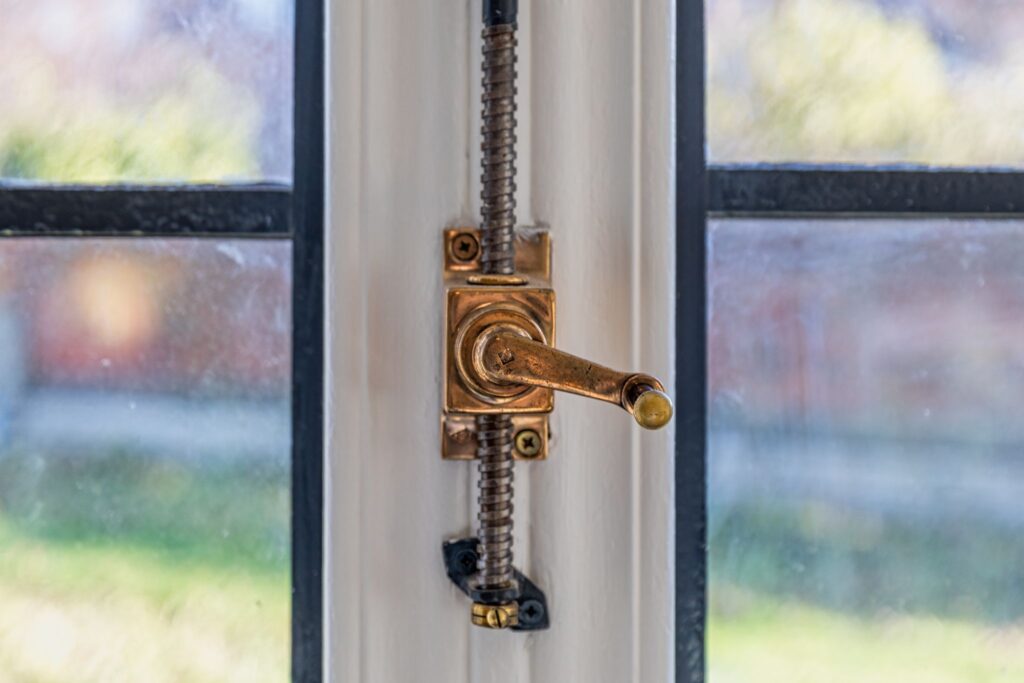
Arts and Crafts Style and Architecture
Arts & Crafts architecture, established in the nineteenth century in Britain, is noted for its expressive use of natural materials and as a platform to allow craftsmen express their skills through painstaking decorative style. Arts & Crafts style, showcased by Jameson House, incorporates low pitched roofs with wide eaves and high triangular roof angles, high granite chimney stacks, a profusion of bay windows, entrance porch with rectangular columnar design, dormer windows, pebble dash render, dominant fireplaces and decorative windows with small glass panes. And craftsman flourishes in every room.
The architect was Frederick George Hicks of Batchelor & Hicks (founded in 1905 and based at 86 Merrion Square). Their other notable Dublin projects include Cooldrinagh, Foxrock (home to Samuel Beckett), Iveagh Markets (for the Guinness family), AIB on O’Connell Street, Dublin and RIAC on Dawson Street, Dublin.
The Refurbishment
When acquired in 2013 the property had planning permission to convert to 12 apartments and to build six new family homes on the 1 acre site. The decision was taken to scale back the development to the current configuration with no new homes and the refurbishment to contain 11 apartments. While financially disadvantageous this has allowed for a more modest but very high quality development focussed on the best of conservation and high quality residential development, retaining the original drawing room intact, and retaining extensive gardens and outdoor space. The refurbishment has been achieved with no amendment to the overall property curtilage and with the least interference to the internal layout feasible.
Everything was built to the highest standards achievable in Jameson House in 1910 and the painstaking refurbishment of the past several years has restored this important historical building to its original glory. Some highlight features of the refurbishment are as follows :
Roof: All original Welsh Green slate roofing, unusual in Irish properties, have been retained. None of the roofing curtilage has been interfered with in the project.
Windows : the windows at Jameson House are a key feature of the building and were a major focus of the refurbishment. They were originally constructed by Crittall Windows, a world leader in metal frame windows and particularly associated with the Arts and Crafts and Art Noveau movements. The company was established in 1849 and supplied windows to the Houses of Parliament and the Tower of London. Each of the 97 original Crittall metal windows were painstakingly removed, refurbished to double glass pane functionality, iron work refurbished as required and then reinstalled. This twenty four month project, led by [xxx] resulted in 90% of the original windows being saved and brought back to original glory, with only a handful requiring bespoke replacement.
Drawing Room : The principal drawing room, to be used as a common room, is a three bay room with fine walnut wood panelling to the chimney breast and surround walls and incorporates glazed library cabinets. Each bay opening has an architrave, window seat and casement windows. Pitched pine flooring throughout has all been fully retained and refurbished.
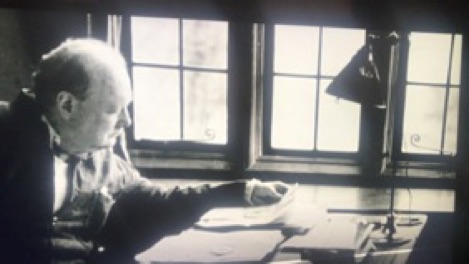
Photo from Chartwell House, Churchill’s home, showing Crittal metal window frames
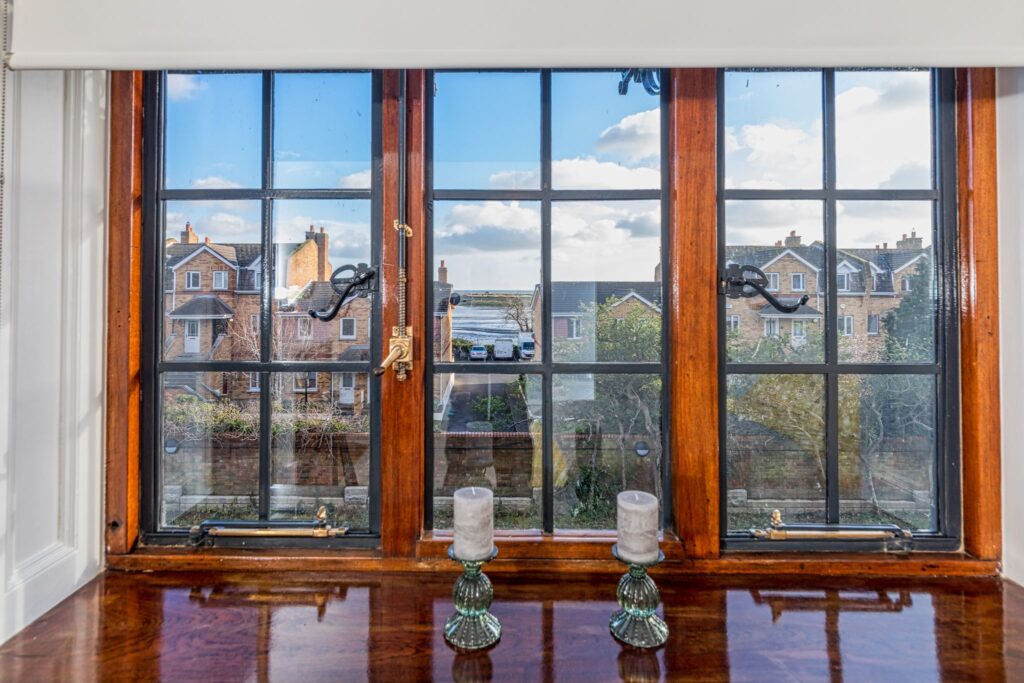
Window detail from Apt 10, showing Crittal metal window frame, similar to Chartwell House.
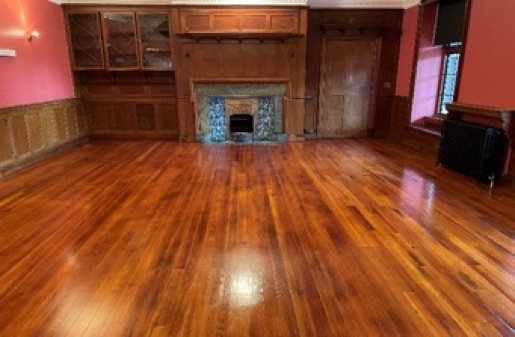
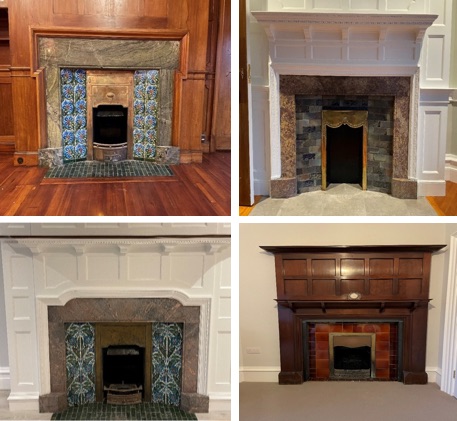
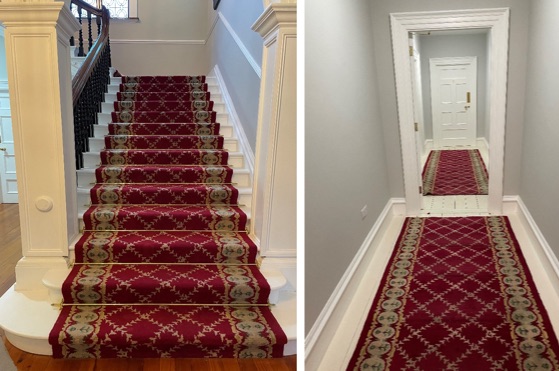

Front door lock. Made by James Gibbons.
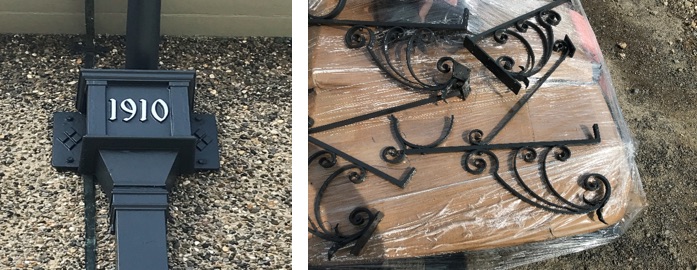
Down pipe. Note the commissioned cereal grain artwork which mirrors the oak carving at the entrance door. Also, refurbished holding brackets for the guttering at the rear of the property.
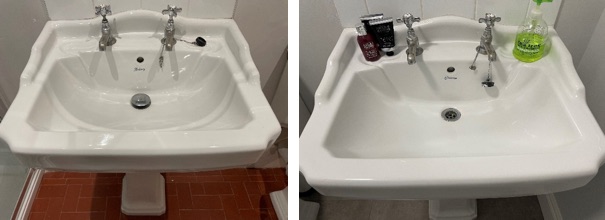
Fireplaces ; The property was constructed with 27 fireplaces. All 27 have been retained in the refurbishment.
Carpet : Donegal Carpets is a trademark brand of handmade wool carpets that was established in 1898. Jameson House would have been one of its earliest customers. Donegal Carpet, hand woven and fitted, inter alia, in Dublin Castle, Buckingham Palace and the White House in Washington, is regarded as the Irish equivalent of Persian carpet. Early examples like that in Jameson House are exceptionally rare and valuable (a 1905 Donegal Arts and Crafts carpet being sold by Christies in New York for $85,000 in 2003. Early 1900’s Donegal Carpet rugs have become collectors items and can fetch €50,000). In the renovation we achieved a project highlight in saving this carpet in the main stairway and landing area using sensitive restoration principles.
Plasterwork and Ceiling Cornicing : Refurbished and retained throughout the building and an architectural highlight in common areas and some apartments. The elliptical vaulted decorative plasterwork ceiling in the main hall has been preserved. Elsewhere, in compliance with fire regulations and apartment fire separation requirements, the original plasterwork is retained above false ceilings that house fire separation boards.
Ironmongery : By the late 19th Century the ironmongery business of James Gibbons had established a reputation for supreme craftsmanship with commissions including Buckingham Palace and the Westminster Houses of Parliament. And his locksmith work is evident in the principal doors in the house and have been retained.
Cast Iron Rain Water Goods : The Arts and Crafts movement brought about renewed interest in wrought ironwork, seen in still surviving Edwardian terraces and canopies in Dublin. In Jameson House the guttering ironwork was constructed at Walter McFarlane’s world renowned Saracen foundery in Glasgow, which exported decorative ironwork worldwide. McFarlanes work is also to be seen in Dublin in the fountain and canopy at Dun Laoghaire seafront and the wrought iron canopy at the Olympia theatre in Dame Street. In our refurbishment project all rain water goods were dismantled and removed off site for replacement of rusted elements and complete renovation prior to replacement on site. The original construction quality of McFarlanes ironwork is exceptional and we managed to save over 95% of original material.
Sanitary Ware : A project of this nature requires new sanitaryware for new apartments. In line with our Sustainability (reuse where possible) focus, and thanks to the efforts of our contractor Eamon G Murphy, we were able to avail of sanitaryware being replaced out of the Gresham Hotel in Dublin where a renovation was replacing the old with the new. Our opportunity to make use of these wash hand basins, means we give a second life to sanitaryware used in Dublin’s most glamourous hotel of much of the 1900’s. The Gresham is noted as the setting for the final third of James Joyce ‘The Dead’ and was visited by the good and the great of the 1900’s including, inter alia, Princess Grace and The Beatles.

